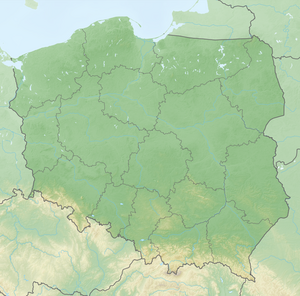Prince Heinrich Baude
| Prinz-Heinrich-Baude (Polish: Schronisko im. Księcia Henryka) (departed) |
||
|---|---|---|
|
Postcard of the hut from 1910, in the background the Schneekoppe |
||
| location | Above the Wielki Staw ; Poland | |
| Mountain range | Giant Mountains , Sudetes | |
| Geographical location: | 50 ° 45 ′ 20 " N , 15 ° 41 ′ 28" E | |
| Altitude | 1415 m npm | |
|
|
||
| Built | 1889 | |
| Construction type | Hut; Stone, wood | |
The Prinz-Heinrich-Baude (also Prinz Heinrichsbaude or Heinrichsbaude , Czech: Bouda prince Jindřicha , Polish: Schronisko im. Księcia Henryka ) was a hut in the Polish (Silesian) part of the Giant Mountains , which was reached and supplied from Krummhübel . From the Spindlerbaude from the west it was about halfway along the today Freundschaftsweg mentioned ridge path to Schlesierhaus direction Snezka . Here the Prinz-Heinrich-Baude stood east of the Mittagsstein ( Slonecznik ) on the Great Pond ( Wielki Staw ).
history
The hut was built in the years 1888/89 in an exposed position on the mountain ridge above the Great Pond as the first tourist mining hut in the Giant Mountains at an altitude of 1410 m . Gustav Elsner was the builder and owner until 1919. The building was named Prinz-Heinrich -Baude after the younger brother of the last German Emperor Wilhelm II.
The hut had 30 rooms with 70 beds and was equipped with the latest technology at the time, it already had a spring water pipe, baths, central heating, telephone (according to Krummhübel) and acetylene gas light. In the next few years, the building fabric was expanded.
Around 1888 there were no tourist buildings in the Giant Mountains, with the exception of those on Śnieżka. Guest and lodging houses were merely additions to existing farmhouses in villages on the edge of the mountains in Krummhübel. The Prinz-Heinrich-Baude was built at the end of the few existing poorly developed hiking trails to the ridge that are no longer available today. In 1888 Elsner received permission from Count Schaffgotsch as the landlord to build the building and master builder Hermann Kahl-Arnsdorf then made a drawing. The inauguration took place on June 8, 1889.
Dr. Baer dedicated his poem Das Lied von der Baude to her in 1888 .
The Heinrichsbaude found literary mention in the tenth chapter of Theodor Fontane's novel Die Poggenpuhls : Sophie von Poggenpuhl is forced to spend the night with relatives in the Heinrichsbaude after she was injured while riding the horn sledge and sends her mother a postcard from the building .
After the end of the Second World War and Poland shifted to the west, the northern part of the Giant Mountains came to Poland with the hut. It burned down in 1946. It was not rebuilt. Today (2017) the foundation walls of the hut still provide seating a few meters south of the Kammweg.
memory
In 2002, the Czech diving school Tritonsport Pardubice undertook an expedition to conduct scientific research and search for traces of historical artefacts from the small and large ponds. In addition to shards with the "Prinz-Heinrich-Baude" emblem, the most interesting find was the torso of a life-size bronze bust, presumably an image of Prince Heinrich.
In 2004, a brass plaque with a picture and text in Polish was set up at the former location of the Prinz-Heinrich-Baude.
Web links
Individual evidence
- ↑ Georg Gürich : Geological Guide to the Riesengebirge , Brothers Borntraeger (1900), page 178
- ↑ Dr. Baer, Das Lied von der Baude , publishing house of the Riesengebirgsverein
- ↑ Theodor Fontane, The Poggenpuhls in the Google Book Search





